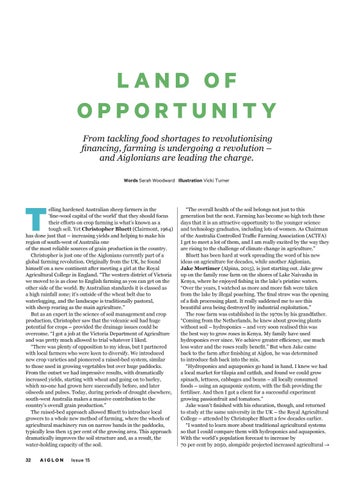LAND OF OPPORTUNITY From tackling food shortages to revolutionising financing, farming is undergoing a revolution – and Aiglonians are leading the charge. Words Sarah Woodward Illustration Vicki Turner
T
elling hardened Australian sheep farmers in the ‘fine-wool capital of the world’ that they should focus their efforts on crop farming is what’s known as a tough sell. Yet Christopher Bluett (Clairmont, 1964) has done just that – increasing yields and helping to make his region of south-west of Australia one of the most reliable sources of grain production in the country. Christopher is just one of the Aiglonians currently part of a global farming revolution. Originally from the UK, he found himself on a new continent after meeting a girl at the Royal Agricultural College in England. “The western district of Victoria we moved to is as close to English farming as you can get on the other side of the world. By Australian standards it is classed as a high rainfall zone; it’s outside of the wheat belt due to waterlogging, and the landscape is traditionally pastoral, with sheep rearing as the main agriculture.” But as an expert in the science of soil management and crop production, Christopher saw that the volcanic soil had huge potential for crops – provided the drainage issues could be overcome. “I got a job at the Victoria Department of Agriculture and was pretty much allowed to trial whatever I liked. “There was plenty of opposition to my ideas, but I partnered with local farmers who were keen to diversify. We introduced new crop varieties and pioneered a raised-bed system, similar to those used in growing vegetables but over huge paddocks. From the outset we had impressive results, with dramatically increased yields, starting with wheat and going on to barley, which no-one had grown here successfully before, and later oilseeds and pulses. Today, during periods of drought elsewhere, south-west Australia makes a massive contribution to the country’s overall grain production.” The raised-bed approach allowed Bluett to introduce local growers to a whole new method of farming, where the wheels of agricultural machinery run on narrow bands in the paddocks, typically less then 15 per cent of the growing area. This approach dramatically improves the soil structure and, as a result, the water-holding capacity of the soil.
32
AIGLON
Issue 15
“The overall health of the soil belongs not just to this generation but the next. Farming has become so high tech these days that it is an attractive opportunity to the younger science and technology graduates, including lots of women. As Chairman of the Australia Controlled Traffic Farming Association (ACTFA) I get to meet a lot of them, and I am really excited by the way they are rising to the challenge of climate change in agriculture.” Bluett has been hard at work spreading the word of his new ideas on agriculture for decades, while another Aiglonian, Jake Mortimer (Alpina, 2015), is just starting out. Jake grew up on the family rose farm on the shores of Lake Naivasha in Kenya, where he enjoyed fishing in the lake’s pristine waters. “Over the years, I watched as more and more fish were taken from the lake by illegal poaching. The final straw was the opening of a fish processing plant. It really saddened me to see this beautiful area being destroyed by industrial exploitation.” The rose farm was established in the 1970s by his grandfather. “Coming from the Netherlands, he knew about growing plants without soil – hydroponics – and very soon realised this was the best way to grow roses in Kenya. My family have used hydroponics ever since. We achieve greater efficiency, use much less water and the roses really benefit.” But when Jake came back to the farm after finishing at Aiglon, he was determined to introduce fish back into the mix. “Hydroponics and aquaponics go hand in hand. I knew we had a local market for tilapia and catfish, and found we could grow spinach, lettuces, cabbages and beans – all locally consumed foods – using an aquaponic system, with the fish providing the fertiliser. And then I got a client for a successful experiment growing passionfruit and tomatoes.” Jake wasn’t finished with his education, though, and returned to study at the same university in the UK – the Royal Agricultural College – attended by Christopher Bluett a few decades earlier. “I wanted to learn more about traditional agricultural systems so that I could compare them with hydroponics and aquaponics. With the world’s population forecast to increase by 70 per cent by 2050, alongside projected increased agricultural
